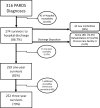New Morbidity and Discharge Disposition of Pediatric Acute Respiratory Distress Syndrome Survivors
- PMID: 30024428
- PMCID: PMC6185805
- DOI: 10.1097/CCM.0000000000003341
New Morbidity and Discharge Disposition of Pediatric Acute Respiratory Distress Syndrome Survivors
Abstract
Objectives: Much of the research related to pediatric acute respiratory distress syndrome has focused on inhospital mortality and interventions affecting this outcome. Limited data exist on survivors' morbidity, hospital disposition, and 1-year survival. The aim of this study was to determine new morbidity rate, discharge disposition, and 1-year mortality for survivors of pediatric acute respiratory distress syndrome.
Design: Secondary analysis of prospective cohort study.
Setting: Quaternary children's hospital.
Patients: Three-hundred sixteen mechanically ventilated children with pediatric acute respiratory distress syndrome (Berlin and Pediatric Acute Lung Injury Consensus Conference criteria) between July 2011 and December 2014.
Interventions: None.
Measurements and main results: We performed secondary analysis of a prospectively recruited cohort of 316 mechanically ventilated children with pediatric acute respiratory distress syndrome between July 2011, and December 2014. Preillness and hospital discharge Functional Status Scale score were determined via chart review, and factors associated with new morbidity, defined as an increase of Functional Status Scale score of 3 or more, were analyzed. Demographic variables, pediatric acute respiratory distress syndrome characteristics, and ventilator management were tested for association with development of new morbidity, discharge disposition, and 1-year mortality. Inhospital mortality of pediatric acute respiratory distress syndrome was 13.3% (42/316). Of 274 survivors to hospital discharge, new morbidity was seen in 63 patients (23%). Discharge to rehabilitation rate was 24.5% (67/274) and associated with development of new morbidity. One- and 3-year mortality of survivors was 5.5% (15 deaths) and 8% (22 deaths) and was associated with baseline Functional Status Scale, immunocompromised status, Pediatric Risk of Mortality III, and organ failures at pediatric acute respiratory distress syndrome onset, but not with pediatric acute respiratory distress syndrome severity.
Conclusions: New morbidity was common after pediatric acute respiratory distress syndrome and appears to be intermediate phenotype between survival without morbidity and death, making it a useful metric in future interventional and outcome studies in pediatric acute respiratory distress syndrome.
Conflict of interest statement
Figures
Comment in
-
Pediatric Acute Respiratory Distress Syndrome Survivors-What Happens After the PICU?Crit Care Med. 2018 Nov;46(11):1866-1867. doi: 10.1097/CCM.0000000000003375. Crit Care Med. 2018. PMID: 30312229 No abstract available.
References
-
- Zimmerman JJ, Akhtar SR, Caldwell E, et al. Incidence and outcomes of pediatric acute lung injury. [Internet] Pediatrics. 2009;124:87–95. Available from: http://www.ncbi.nlm.nih.gov/pubmed/19564287. - PubMed
-
- Pediatric Acute Lung Injury Consensus Conference Group. Pediatric acute respiratory distress syndrome: consensus recommendations from the Pediatric Acute Lung Injury Consensus Conference. [Internet] Pediatr Crit Care Med. 2015;16:428–39. Available from: http://www.ncbi.nlm.nih.gov/pubmed/22008400. - PMC - PubMed
-
- Yehya N, Servaes S, Thomas NJ. Characterizing Degree of Lung Injury in Pediatric Acute Respiratory Distress Syndrome [Internet] Crit Care Med. 2015;43:937–946. Available from: http://content.wkhealth.com/linkback/openurl?sid=WKPTLP:landingpage&an=0.... - PubMed
-
- Yehya N, Servaes S, Thomas NJ, et al. Corticosteroid exposure in pediatric acute respiratory distress syndrome [Internet] Intensive Care Med. 2015;41:1658–1666. Available from: http://link.springer.com/10.1007/s00134-015-3953-4. - DOI - PubMed
Publication types
MeSH terms
Grants and funding
LinkOut - more resources
Full Text Sources
Other Literature Sources
Medical


